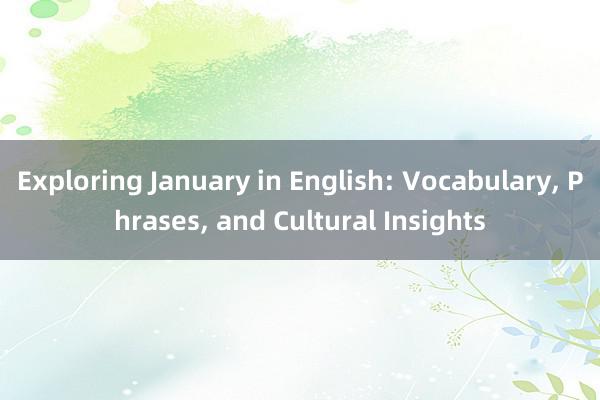
### Exploring January in English: Vocabulary, Phrases, and Cultural Insights
January, the first month of the year, is not just about New Year's resolutions and fresh starts; it's also a time rich with cultural traditions, vocabulary, and phrases企业-臣雅远棉类有限公司 that reflect its unique place in the calendar. In this article, we'll delve into the linguistic and cultural aspects of January in English-speaking countries, offering insights that can enhance your understanding and appreciation of this month.
#### Vocabulary
**1. **New Year’s Eve (December 31) and New Year’s Day (January 1): These terms are fundamental to the celebration of the transition from one year to the next. They are often associated with fireworks, parties, and the making of resolutions for the upcoming year.
**2. **Winter Solstice: Although not specific to January, the Winter Solstice marks the day with the fewest hours of daylight, occurring around December 21 or 22 each year. It signifies the beginning of longer days and is celebrated in various cultures with rituals and festivals.
**3. **Cold Fronts and Frost: January in many regions is characterized by cold weather, leading to discussions around temperature drops, snowfall, and the need for warm clothing. Terms like "blizzard," "frostbite," and "ice storm" become relevant in conversation.
牡丹江市天业进出口有限责任公司#### Phrases
**1. **"Happy New Year!" is a common greeting used worldwide during the month of January, reflecting the global celebration of the new year.
**2. **"Auld Lang Syne" is a Scottish poem written by Robert Burns that is often sung at the stroke of midnight on New Year’s Eve, symbolizing friendship and reminiscence.
**3. **"Countdown to midnight" is a phrase commonly used to describe the excitement and anticipation of the New Year’s Eve celebrations,企业-臣雅远棉类有限公司 where people count down the seconds until midnight.
#### Cultural Insights
**1. **In the United States, January 1st is not only a national holiday but also the day when many make personal resolutions, often referred to as "New Year's Resolutions." This tradition emphasizes personal growth and self-improvement.
**2. **In the UK, January is often associated with "Dry January," a campaign encouraging people to abstain from alcohol for the entire month as a way to improve health and financial habits.
**3. **In many Latin American countries, January is known for the celebration of Three Kings' Day (Día de los Reyes Magos), a Christian holiday where gifts are exchanged, similar to Christmas, but later in the calendar.
**4. **In China, the Chinese New Year, which typically falls in January or February, is a significant festival celebrated with family reunions, fireworks, and the giving of red envelopes containing money.
#### Conclusion
January, with its blend of cultural celebrations, vocabulary, and phrases, offers a rich tapestry for exploration in the English language. Whether it's the excitement of New Year's Eve, the contemplation of resolutions, or the warmth of traditional festivities across different cultures, this month invites us to celebrate beginnings and cherish our connections. Understanding these elements can enrich your English language skills and deepen your appreciation of the diverse ways in which January is celebrated globally.